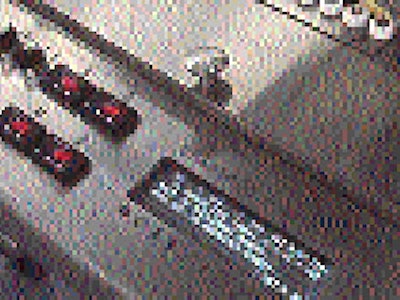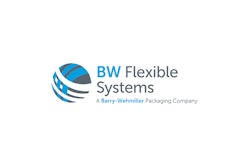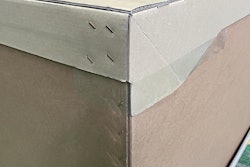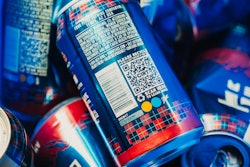Until last year, Saputo Cheese had to "quarantine" its production of wrapped cheese blocks for 24 hours to make certain the packs were properly sealed before packing and shipping. That's because the leaker rate for packages produced on the flow wrapper exceeded 5%. Thanks to a new overwrapper, installed early in '95, that quarantine has ended. And so have the package leaker problems for Montreal, Quebec-based Saputo. The company has seen poor seals drop to well under one-half of 1%. In fact, after just one shift of production with the new machine, the leaker rate was 0.32%, reports Lino Saputo, Jr., the vice president of production. That was confirmed by the last overnight quarantine that Saputo has needed. The "quarantine" period lets the CO2 gas injected into the package at sealing be absorbed into the moisture of the cheese. When the gas is absorbed into the product, the loose overwrap is pulled tight around the chunk of cheese, almost resembling a vacuum package. If the wrap is still loose after 24 hours, that package is believed to have a poor seal. Then the product has to be unpackaged and rewrapped. The new machine is the Integra from Rose Forgrove (St. Charles, IL), and Saputo is the first North American installation. It's a horizontal wrapper that some call a horizontal form/fill/seal or a flow wrapper. Roll film is fed over a forming box so a fin-seal can be made below the bed of the machine. Into the tube of film, the product is fed until transverse sealing jaws seal ahead and then behind the product to make a pouch. Just before the back seal is made, a tube shoots a puff of CO2 around the product that displaces most of the oxygen in the package. Those words could describe a dozen other wrappers. So why did Saputo select the Integra? Simple but up-to-date "What we liked best about this machine was its simplicity," says Lino Jr. "On many wrappers, you have multiple sets of jaws, each of which needs to be closely controlled for time and pressure to get good seals. This machine has but a single set of jaws, and the temperatures can be constantly monitored. If either jaw or the fin sealer gets beyond the parameters for temperature, pressure or dwell time, it can be identified quickly and be easily corrected. That virtually eliminates the production of a large number of packs without good seals." The Integra was not Saputo's first choice. That's because the company first sought a machine made by the company that manufactures most of the packaging machinery in that plant. Eventually, Saputo began negotiating with several suppliers to locate the machine that would best meet its needs. When Saputo's packaging people visited Pack Expo in '94, they were told to check for machines that had not been considered. That's how George Znoj, senior project engineer, came across the Integra from Rose Forgrove. Before Saputo could get a proposal for this wrapper, Rose Forgrove wanted to ensure the Integra would perform well for this application. RF machines had been well tested in the bakery market, but cheese wrapping was a new application. "What really impressed us about Rose Forgrove was that before they would even quote on a machine, they wanted samples of the product and the material so they could conduct tests in their plant," Lino Jr. says. "Once they had run the products, they felt confident enough to guarantee a leaker rate of less than one percent." That was very persuasive to the cheese company. Same material as before What makes the comparison of the Integra with the former machine especially valid is that the company continues to use exactly the same packaging material as before. This machine is used to package four sizes of Saputo's chunk cheeses, from 227 to 454 g, of a wide variety of products from American mozzarella to brick to cheddar. Along with Saputo's own brands, the plant also packages under a sizable list of private labels. The material for all is Curpolene® 600XLT in a 3.1-mil thickness from Curwood (Oshkosh, WI). The film is a 48-ga polyvinylidene chloride coated polyester that's reverse-printed flexo in up to six colors. The polyester is then adhesively laminated to a 49-ga coextruded OPP film that's extrusion-laminated with a 1.5-mil layer of an ethylene vinyl acetate copolymer for good flowability at low temperatures. "Our packaging is exclusively for retail, so it's important for us that the integrity of packaging be as good as we can get," Lino Jr. says. That's why the company uses a sophisticated structure with an 18% EVA seal layer that permits low temperature sealing. The major cause of leakers is film wrinkling in the seal area, and the flowability and thickness of the seal ply can provide good seals even with some wrinkles. The Integra also provides a "walking beam" seal system that permits longer dwell times. The seal jaws and conveyor are mounted on an assembly that moves with the package for a distance, then disconnects and returns to the seal point. This isn't terribly important yet because Saputo isn't operating at anywhere near the the machine's top speed. "At this point, we're very satisfied with the output of the machine, and we know it can do a lot more," Lino Jr. says. "Since we don't have an automated block cheese cutter, we can only feed product to the wrapper at about 50 to 55 chunks per minute. We believe the machine will do 80 to 100 per minute, and our next project will be to automate cheese cutting." Still simple to operate In operation, chunks of cheese are loaded into the flights on the removable infeed system. Film unwinds off the roll past an ink-jet coder from Domino Amjet (Gurnee, IL) that applies both a production code and a "best by" date. The film continues over the forming box where it's sealed into a tube. As the cheese is conveyed into the film tube, it's just below the gas flush tube. When the product reaches the reciprocating jaws that provide the end seal, the gas tube provides a supply of CO2 gas that drives out ambient air. The traveling head then seals the trailing edge of the package. The package is ejected from the machine and is conveyed through a metal detector from Cintex (Kenosha, WI) just before it's conveyed through the wall to the pack-off area. For extra sanitation, Saputo separates its operation into three discrete rooms. In the first, 640-lb blocks of cheese are unpackaged and conveyed through a wall into the processing/packaging room. After packaging, the pack-off and palletizing room is in a separate area. "This helps us to eliminate most types of contamination, like dust from pallets or corrugated cases from our product and packaging area," says Lino Jr. Easy to clean Even though the Integra is a very sophisticated machine, it's designed with sanitation in mind, Znoj points out. "The cantilevered design of the machine makes it easy to keep clean. The discharge belt can be removed without tools, and the infeed system can be wheeled away from the wrapper for wash-down. This is a well-thought-out machine design," Znoj concludes.



























